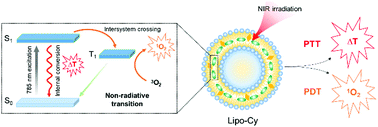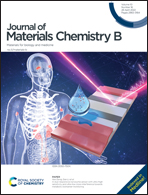Liposomal cyanine dyes with enhanced nonradiative transition for the synergistic phototherapy of tumors†
Abstract
Organic photosensitizers are of great interest in cancer diagnosis and treatments such as fluorescence imaging, photodynamic therapy (PDT), and photothermal therapy (PTT). However, their poor aqueous solubility, inadequate photostability and unsatisfactory photophysical parameters limit their clinical application. Herein, we report the construction of liposome encapsulating cyanine dye Cypate (Lipo-Cy) with enhanced nonradiative transition for efficient cancer therapy. After being loaded in liposomes, Cypate molecules are spatially confined within the hydrophobic lipid bilayer, thereby causing much better stability, higher photothermal conversion efficiency, and increased singlet oxygen quantum yield than free Cypate via enhanced nonradiative transition through π–π aggregation. Lipo-Cy further enhanced the cellular uptake of Cypate, as well as preferable tumor accumulation and retention, leading to abundant intracellular singlet oxygen and potent hyperthermia at the tumor for effective PTT synergized PDT, even at dosages 10 times less than free Cypate. The Lipo-Cy exhibited superior anticancer efficiency, showing great prospects for clinical translation.



 Please wait while we load your content...
Please wait while we load your content...